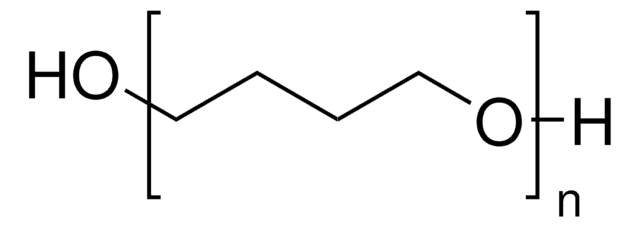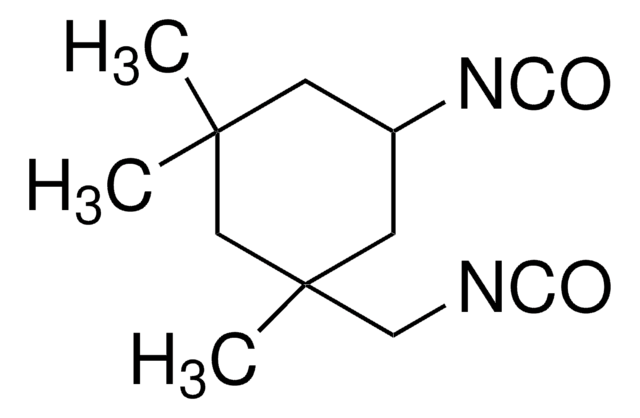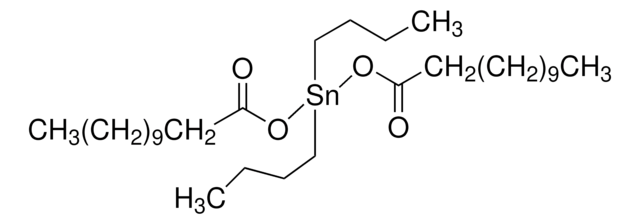345296
Poly(tetrahydrofuran)
average Mn ~1,000
Synonym(s):
α-Hydro-ω-hydroxypoly(oxy-1,4-butanediyl), Poly(1,4-butanediol), polyTHF
Sign Into View Organizational & Contract Pricing
All Photos(2)
About This Item
Linear Formula:
H(OCH2CH2CH2CH2)nOH
CAS Number:
MDL number:
UNSPSC Code:
12162002
PubChem Substance ID:
NACRES:
NA.23
Recommended Products
vapor pressure
<0.01 mmHg ( 25 °C)
<1 mmHg ( 20 °C)
Quality Level
mol wt
average Mn ~1,000
contains
0.05-0.07% BHT as stabilizer
mp
25-33 °C
density
0.974 g/mL at 25 °C
SMILES string
OCCCCO
InChI
1S/C8H18O2/c1-3-5-6-10-8(4-2)7-9/h8-9H,3-7H2,1-2H3/t8-/m0/s1
InChI key
BJZYYSAMLOBSDY-QMMMGPOBSA-N
Looking for similar products? Visit Product Comparison Guide
Related Categories
Application
Poly(tetrahydrofuran) can be used as a starting material to prepare:
- Thermally reversible urethane -epoxy networks.
- Poly(hexamethylene 2,6-naphthalate)-block-poly(tetrahydrofuran) (PHN-b-N-pTHF) copolymers with shape memory effect via melt polycondensation.
- Poly(3,4-ethylenedioxythiophene):poly(tetrahydrofuran) composite for the fabrication of memory organic electrochemical transistors.
Features and Benefits
- High flexibility
- Hydrolytic stability
- Excellent abrasion resistance
Storage Class Code
11 - Combustible Solids
WGK
WGK 3
Flash Point(F)
>325.4 °F - Tag open cup
Flash Point(C)
> 163 °C - Tag open cup
Personal Protective Equipment
dust mask type N95 (US), Eyeshields, Gloves
Choose from one of the most recent versions:
Already Own This Product?
Find documentation for the products that you have recently purchased in the Document Library.
M Renier et al.
Journal of biomaterials science. Polymer edition, 5(3), 231-244 (1993-01-01)
Poly(etherurethane urea) (PEUU) elastomers when employed as biomedical devices may be susceptible to extraction upon implantation. Four PEUU elastomers containing a single PEUU formulation, but varying in terms of their additives, were subjected to an in vitro extraction procedure. The
P Banu et al.
Journal of colloid and interface science, 277(2), 304-308 (2004-09-03)
Aqueous dispersions of poly(ester-imide)s [P(E-I)s] have been prepared by dispersing the P(E-I)s in water without any external solubilizing agents. P(E-I)s were prepared from anhydride-terminated polyester prepolymer and diisocyanate. The -COOH groups in the polymer were then neutralized using triethylamine and
A Takahara et al.
Journal of biomaterials science. Polymer edition, 5(3), 183-196 (1993-01-01)
The relationships among surface, bulk properties and lipid sorption behaviors of segmented polyurethanes (SPUs) with various polyol soft segments were investigated. The polyols used in this study were poly(ethylene oxide) (PEO), poly(tetramethylene oxide) (PTMO), and poly(dimethylsiloxane) (PDMS). The hard segment
Antony Memboeuf et al.
Journal of the American Society for Mass Spectrometry, 22(10), 1744-1752 (2011-09-29)
Collision induced dissociation tandem mass spectrometry experiments were performed to unequivocally separate compounds from an isobaric mixture of two products. The Survival Yield curve was obtained and is shown to consist in a linear combination of the curves corresponding to
W K Loke et al.
Biomaterials, 17(22), 2163-2172 (1996-11-01)
Hybrid biomaterials have been produced by the interaction of polyurethane oligomers with both fresh and glutaraldehyde-fixed porcine pericardium. The hybrid biomaterials so formed were translucent with occasional white streaks and/or spots, had increased stiffness (to touch) but remained pliable. No
Global Trade Item Number
| SKU | GTIN |
|---|---|
| 345296-25ML | 4061837797323 |
| 345296-18L | 4061837797316 |
| 345296-1L | 4061826760536 |
| 345296-3L | 4061826760543 |
Our team of scientists has experience in all areas of research including Life Science, Material Science, Chemical Synthesis, Chromatography, Analytical and many others.
Contact Technical Service







